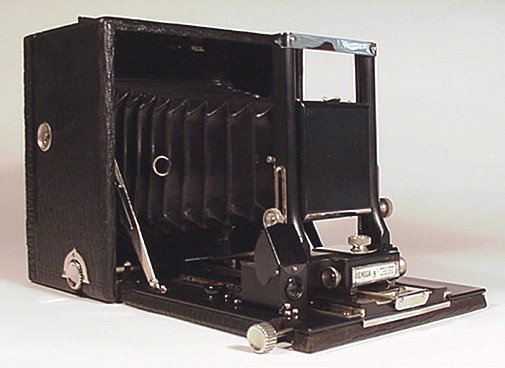
Seneca No. 9 Camera

This Seneca No. 9 camera, dating from the early 1900s is in pristine condition, showing little if any use. Its accompanying plate holders however bear exposure notations in pencil by a former owner. So I think the camera was probably used.
Seneca Camera Company was located in Rochester, New York. It operated from 1900 until 1924, when it was was sold to Conley, a Sears Roebuck subsidiary. Seneca produced dozens of camera models during this period. I think that Seneca may have pioneered the acceptance of polished black-paint wood cameras at a time when most wooden cameras were naturally finished. In fact a popular line of Seneca cameras was named Black Beauty. Seneca offered unpainted, finely finished cameras as well, but these were sold at a higher price as they were more expensive to produce.
In the early 1900s photographs were typically taken on glass plates. Sheet film was not yet in common use. Image format is 3 1/4 x 5 1/2 inches, a size commonly known as postcard size. Postcard format cameras were made in great numbers by many manufacturers, but I believe this size is uncommon in the No. 9 model line. Eastman Kodak's first postcard format camera was the 3A Folding Pocket Kodak.
It is probably obvious from the photographs that this example does not have a lens. It is fitted with an un-drilled lens board. A lens was never mounted on this board. By the way, lens boards for this camera have a proprietary design. It was necessary to purchase a Seneca board for lens mounting.
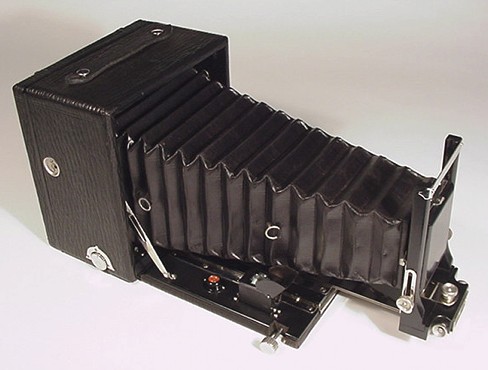
The camera has a double-extension bellows. This allowed mounting of long focal length lenses. A double-extension camera was expensive to manufacture. It required additional sturdy support for the bellows and lens standard, and a much longer bellows. The bellows on this example is a rich, deep black color and very supple, and although it looks like vinyl in the photograph, it is made of quality leather.
Notice an orange circle on the camera bed. This is a spirit level. The liquid is still present. The body is made of wood, painted black and highly polished. The covering is thick leather with a heavy grain pattern. The metal fittings have a polished nickel plating.
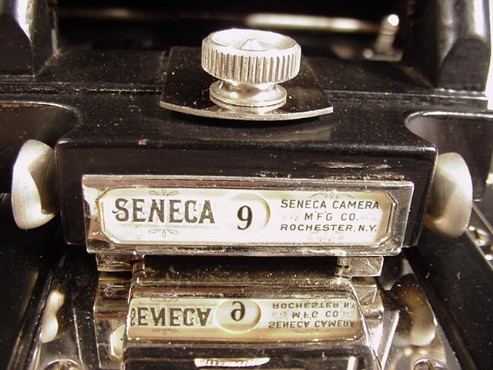
I should have done a better job of dusting the camera before taking this photograph.
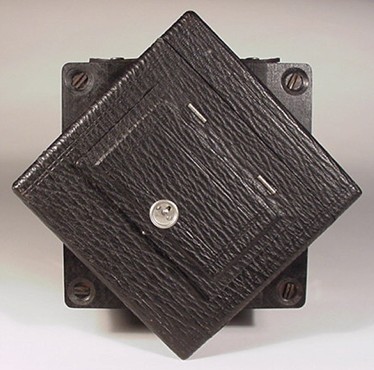
This photograph shows the revolving back in action. The camera back is not removable, but it rotates and locks into position for both horizontal and vertical photographs.
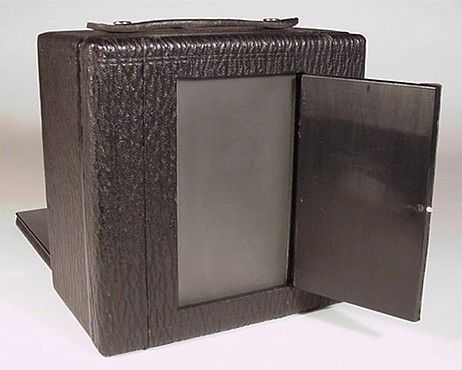
The ground glass screen is used to compose and focus the scene. Light from the lens falls on the screen giving a precise view of the subject. The lens standard is adjusted forward and backward until the subject appears sharp. Then a plate holder is inserted into the camera back and the exposure is taken. The ground glass is protected from accidental breakage by a hinged flap. The flap also helps to shield extraneous light from the screen, making it easier to see the dim screen image. Often a photographer would drape a black cloth over the camera back and his/her head to further shield the screen from light.
Composition with a ground glass camera takes some experience as the image seen on the viewing screen is upside down. This inconvenience is due to the laws of optics, not camera design.
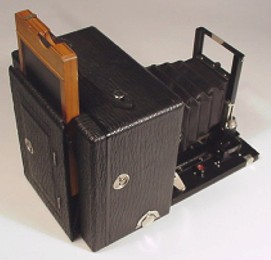
|
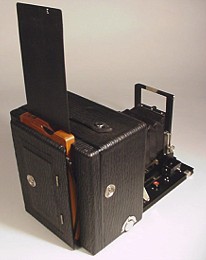
|
Plate Holder Partially and Fully Inserted into Camera Back
Glass plates were loaded in a darkroom into wooden light-tight holders. The holder is inserted into the camera back and held in place by two strong leaf springs. The springs normally hold the ground glass frame against the camera body. When the holder is inserted, it is sandwiched between the ground glass frame and camera body.
The photograph on the right shows the dark slide pulled out of the plate holder. The dark slide is a thin hard black sheet, probably vulcanite, that covers the glass plate until it is time to make the exposure. Then the slide is withdrawn to allow light from the lens to reach the sensitized plate. After exposure, the dark slide is pushed back into the holder.
This is a double plate holder Two glass plates can be loaded into a double holder. Holders came in two varieties — single and double.
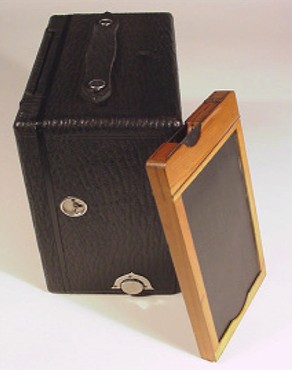
The postcard format No. 9 Seneca closes to a compact size for travel. This is a self-casing camera. The delicate lens and mechanism are well protected when not in use. Its closed dimensions in inches are: 7 wide x 7 high x 4 1/4 deep. When the camera is opened, the depth becomes 10 3/4 inches. The camera weighs approximately 3 1/2 pounds and a holder loaded with two plates weighs 1/2 pound.
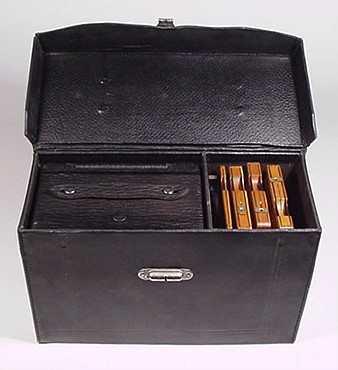
The heavy leather carrying case is well made and still in excellent condition. There is room for the camera, plate holders and a few accessories.
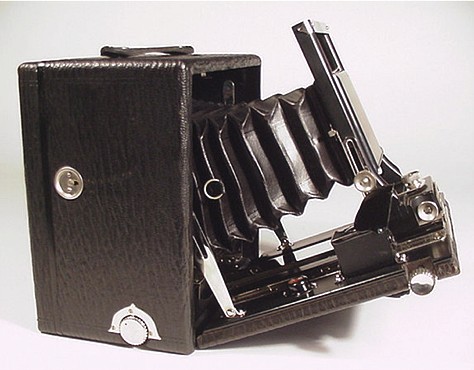
This model knows a few tricks considered useful by large-format photographers. It has a revolving back, shown above. And as you can see, the camera bed can be tilted up. It tilts down as well. The front also has adjustment for rise and fall. That is, the lens board can be slid straight up or down, and locked in that position. An experienced photographer can use these adjustments to alter a scene's perspective.
To tilt the lens standard up or down, the nickel-plated knob seen near the bottom of the camera is pulled straight out and then rotated clockwise or counter-clockwise. Push the knob in to lock the position. The tilt is produced by a well made rack and pinion gearing system that to this day works as well as new.
Focus is also controlled by a smoothly functioning rack and pinion. When the lens standard is pulled from the camera casing and slid along its track the action feels silky smooth.
Having handled many cameras of similar design, I get the impression that the No. 9 Seneca was well designed, and perhaps one of Seneca's best quality models.

|
Page created August 13, 2001;
updated December 20, 2020 |